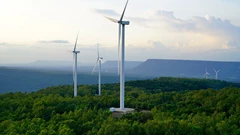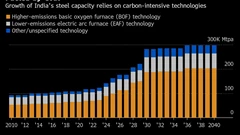Investment in Renewable Energy Needs to Quadruple by 2030
(Bloomberg) -- To reach net-zero emissions by 2050 and limit global warming to 1.5C, investment in renewable energy sources needs to surpass finance flows to fossil fuels by a factor of four over the next decade, according to research from BloombergNEF.
Currently, about 90 cents goes to low-carbon energy sources for every $1 put toward fossil fuels. That ratio needs to change dramatically by 2030, with an average $4 invested in renewables for every $1 allocated to high-polluting energy supplies, analysts at BNEF said. For context, that ratio has never before crossed the 1:1 mark.The numbers show that the decarbonization of the global economy is an undertaking with few parallels in modern history. Investment in the global energy system may climb to as much as $114.4 trillion by 2050, as dollars pour into renewable energy sources including wind and solar, according to BNEF.This decade “is a vital time to kick-start investing in the energy transition and prevent back-loading emission reductions,” the BNEF analysts wrote in a report published Thursday. Scientists have said global greenhouse-gas emissions need to halve by 2030 to avoid catastrophic impacts of climate change. BNEF’s research was commissioned by the Glasgow Financial Alliance for Net Zero, a coalition of banks, asset managers and insurers overseeing a combined $135 trillion of assets. The analysis was aimed at determining the level of investment required to reach net zero and limit global temperature increases to no more 1.5C under seven scenarios from the International Energy Agency, the Intergovernmental Panel on Climate Change and the Network for Greening the Financial System.Comparing investment in low-carbon energy supplies with fossil fuels “offers a new view on how corporations, state and non-state organizations and financial institutions can align their financing activity to climate scenarios,” BNEF said.
More stories like this are available on bloomberg.com
©2022 Bloomberg L.P.
KEEPING THE ENERGY INDUSTRY CONNECTED
Subscribe to our newsletter and get the best of Energy Connects directly to your inbox each week.
By subscribing, you agree to the processing of your personal data by dmg events as described in the Privacy Policy.
More renewables news

WEC Energy Offered $2.5 Billion US Loan for Renewable Projects

With Trump Looming, Biden’s Green Bank Moves to Close Billions in Deals

GE Vernova Expects More Trouble for Struggling Offshore Wind Industry

Climate Tech Funds See Cash Pile Rise to $86 Billion as Investing Slows

GE Vernova to Power City-Sized Data Centers With Gas as AI Demand Soars

Longi Delays Solar Module Plant in China as Sector Struggles

Australia Picks BP, Neoen Projects in Biggest Renewables Tender

SSE Plans £22 Billion Investment to Bolster Scotland’s Grid

A Booming and Coal-Heavy Steel Sector Risks India’s Green Goals
















